Armstrong-Whitworth AW650-222 Argosy
Background
The AW650 was designed by Armstrong-Whitworth to meet a 1955 British Air
Ministry specification for a freight/passenger aircraft suitable for civil
and miltary use. Initially known as the Freightliner, construction started
as a private venture in early 1957. This was the manufacturer's last
project as in 1958 the company was subsumed by the Hawker-Siddeley group,
and the aircraft project was designated the HS.650 Argosy.
The prototype Series 100 freighter (c/n 6651 G-AOZZ) was first flown on
January 8, 1959. Type certification was achieved in December 1959, by
which time six had been completed. The aircraft was displayed in Paris in
July, 1959 and Farnborough in 1960 where it attracted interest but few
orders. The project was not successful in the commercial sector as only
ten were built. Riddle Airlines of Miami, Florida ordered four aircraft, later
increasing that to seven for a contract with the USAF. The three
remaining Series 100 aircraft were sold to BEA. Apart from G-APRM (c/n
6653) all the series 100 aircraft were at some point operated in the USA,
but many eventually returned to the UK. One (c/n 6656 VH-IPD) went on to
work in Australia. All but two of the Series 100 Argosies had been scrapped
by 1990, with the others surviving in UK museums.
A military variant of the AW650 was more successful. After evaluating
the AW650 the RAF ordered 20 aircraft, but wanted a number of alterations
to the aircraft. This included a strengthened wing which raised the MTOW
from 39,916kg (88,000lb) to 55,250kg (121,800lb) and a change from the
1910shp Dart 526 to the 2680shp Dart 101 powerplants. The aircraft had only
a rear cargo door which could be opened in flight (the civil version could
not). The military AW-660 prototype first flew on March 4th 1961, and the
RAF eventually acquired 56 aircraft. The first of these Argosy C.Mk.1
aircraft entered service in 1962, and soon became known as the 'whistling
wheelbarrow' - a product of the aircraft shape and the characteristic sound
of the dart engine. The aircraft was used for freight, troop transporting
and parachute work - and later airfield calibration (seven aircraft being
modified to E.1 models). A further aircraft was modified as a T.2. The RAF
retired the last of its Argosies from active duty in 1975. Most were
scrapped after being withdrawn from use, although five went onto civil use.
These were operated in the UK, US, Phillipines and parts of Africa. Two survive
in museums, one in the US and one in the UK, along with a cockpit section. During their service several Argosy C.Mk.1 aircraft visited New Zealand. Based with 215 Squadron at
Changi in Singapore, these aircraft include XP446 (c/n 6778) which attended
the Air Force day at Ohakea in February 1964 and returned on several other
occaissions, XR108 (c/n 6786) which was on display at the opening of Auckland
International Airport on January 29, 1966, and XP449 (c/n 6781) which
visited Christchurch in September 1966.
A further civil model was developed to try and attract interest in the
type. The series 200 featured a redesigned wing, uprated 2050shp Dart 532
engines, an enlarged hold, wider front and rear cargo doors, and a 181kg
(400lb) lower empty weight. With a MTOW of 42,185kg (93,000lb) payload had
increased from12,700kg (28,000lb) to 14,515kg (32,000lb) with improved
performance overall. The prototype was first flown on March 11, 1964.
However, buyers were not forthcoming, and although BEA ordered 10 only six
were built. The prototype was retained by Hawker Siddeley and after being
withdrawn from use in November 1965 was scrapped in September 1967. The
remaining aircraft were supplied to BEA as replacements for their Series
100 aircraft. Two were lost in service - G-ASXL (c/n 6800) was lost at
Piacenza, Milan on July 4, 1965, and G-ASXP (c/n 6804) was burnt out on the
ground at Stanstead on December 4, 1967. BEA had withdrawn the type by
April 1970. All four surving Series 222s were sold in Canada, being
delivered to Midwest Airlines, later Transair on mining support operations.
Two aircraft (c/n 6803 and c/n 6805) were subsequently sold to SOACO in
Gabon, from where they found their way to IPEC in Australia. Another (c/n
6801) spent time in Ireland before returning to Canada and joining the
other Series 222 (c/n 6802) in New Zealand. The fate of these four is
described below.
New Zealand Operations:
Apart from the RAF visitors noted above, three of the Series 222 Argosies
have been operated commercially in New Zealand from 1974 to 1990 - all by
SAFE Air. Originally known as Straits Air Freight Express (becoming SAFE
Air in 1967), the company was formed in 1950 to tender for the Rail-Air
freight contract across Cook Strait. After initially using a leased
Curtiss Commando aircraft, they operated Bristol B.170
Freighters. The company later expanded into mail and other freight
work, and in 1968 began passenger operations on the Chathams run. SAFE Air
had become a wholly owned subsidiary of NAC in 1972 (which was in turn
merged with Air New Zealand in 1978). The company has its headquarters at
Woodbourne, near Blenheim.
The first of the Series 222 Argosies, CF-TAG (c/n 6801 ex G-ASXM,
CF-TAG, EI-AVJ) arrived in Wellington on October October 27, 1973 having
flown from the USA via Fiji. The aircraft had been leased for two months
to take part in an operational trial. This aircraft had first flown on
February 10, 1965, and was delivered to BEA on Mar 2, 1965 as G-ASXM.
Having completed 13,921 hours with BEA on European cargo routes, the
aircraft was then delivered to Midwest Airways on June 15, 1970 where it
supported mining operations. In November 1971 the aircraft went to Aer
Turas in Ireland where it served for a year before returning to Transair.
On arrival in New Zealand the aircraft was registered ZK-SAF. After the
hold floor was modified to accept SAFE Air 'cargons' - a palletised loading
system, the aircraft went to work on October 31. A Senior Transair
Captain, Tom Murphy acted as instructor as crew conversion commenced. The
trial was successful, and in January 1974 the aircraft was repainted in
SAFE Air colours. Following SAFE Air practice, ZK-SAE was named 'Merchant
Pioneer'. The first SAFE Air crewed commercial flights began the same
month.
A second Series 222 Argosy was delivered from the Transair on July 18,
1974 having been registered ZK-SAE (c/n 6802 ex G-ASXN, CF-TAJ) on June 27.
The delivery route was eastward via Europe, the Middle East, and South-East
Asia. This aircraft had first flown on March 10, 1965, and was delivered to
BEA on Mar 26, 1965 as G-ASXN and subsequently used on European cargo
routes. The aircraft was then delivered to Midwest Airways on July 6, 1970
where it supported mining operations. After being modified to SAFE Air
specifications, the aircraft entered service in September 1974. Following
SAFE Air practice, ZK-SAE was named 'Merchant Enterprise'.
Over their 16 years of service, the Argosy aircraft were used for
freight, mail, and passenger work. Initially the aircraft were operated on
a freight trunk route of Auckland - Wellington - Christchurch with stops at
Woodbourne. The route was later extended to Dunedin and Invercargill with
stops in Hamilton, New Plymouth, and Palmerston North. Occassionally
flights were made to Napier and Timaru. Charter flights outside New
Zealand saw cargo carried to Norfolk Island, Noumea, Port Vila in Vanuatu,
and Brisbane in Australia. On Dec 22, 1981 it was announced that the
Argosies would take over the Chatham Islands run from the Bristol
Freighters. The first flight took place from Christchurch on June 16,
1982. This was a freight and passenger service - passengers being housed
in a removable 'passenger capsule' with standard airline seating
arrangement (ex B737) and facilities, and accompanied by a stewardess.
Chathams flights were later also carried out from Wellington. The use of
the Argosies by SAFE Air allowed the B.170 fleet to be gradually reduced,
and after the end of the rail air contract on December 31, 1983, the
Bristol Freighters were phased out altogether - finally ceasing work for
SAFE Air in September 1986. Like many freight aircraft, the service of the
Argosies was undistinguished and the only time the SAFE Air aircraft
achieved major media attention was after the sighting and subsequent
filming by a television crew of alledged UFO's over the Kaikoura coast in
1978. ZK-SAE was the aircraft involved - while on the
Wellington-Christchurch/ Christchurch-Blenheim run.
The Argosy operation was not altogether without incident. ZK-SAE was
damaged on March 23 1981 at Woodbourne while undergoing maintenance.
During undercarriage retract tests the aircraft collapsed onto the tail of
B170 ZK-CLT which required considerable repair. During the repair of
ZK-SAE cracks were found in the tail assembly and both Argosies were
grounded for corrective work - returning to service in June 1981. ZK-SAF
crash landed at Woodbourne on April 1, 1990 when the port main
undercarriage failed to extend correctly. Although deemed repairable, SAFE
Air considered the repairs uneconomic and the aircraft did not fly again.
At that time the aircraft had completed 47,035 hours and 36,329 cycles. As
a replacement, an Australian based Argosy (c/n 6805 ex G-ATTC, CF-TAZ,
TR-LWR, VH-IPB) was then leased. This aircraft was the final Argosy built
and was delivered to BEA on November 21, 1965 as G-ATTC for use on European
cargo routes. The aircraft was then delivered to Midwest Airways in May
1970 where it supported mining operations as CF-TAZ. In November 1976 the
aircraft went to Gabon where it was registered as TR-LWR to SOACO. In
June 1978 the aircraft was delivered to Australia, being registered to
Interstate Parcel Express Co. (IPEC) as VH-IPB on September 1, 1978. (The
other Series 222 Argosy c/n 6803 followed a similar path - as G-ASXO,
CF-TAX, TR-LWQ, and VH-IPA). Sourced as a replacement for ZK-SAF, VH-IPB
was delivered to New Zealand via Lord Howe and Norfolk Island on April 24,
1990. The aircraft went on the New Zealand register as ZK-SAL on May 8.
Maintenance and modifications were required to make the aircraft
serviceable, and it entered service on May 25. The aircraft subsequently
operated all SAFE Air routes except the Chathams run.
On August 17, 1990 it was announced that SAFE Air would cease flying and
become an Engineering only operation. ZK-SAL continued to operate until
September 16, after which the aircraft was returned to Australia. At that
time the aircraft had completed 28,405 hours and 18,179 cycles. ZK-SAE made
the last flight on September 30th to Wellington and Christchurch. (Four
years to the day from the withdrawal of the last Bristol B170
Freighters).
Fates:
As noted above, ZK-SAL was returned to IPEC in Australia, resuming the
registration VH-IPB on November 2, 1990. However all three IPEC Argosies,
the other two being the above mentioned VH-IPA and a Series 100 VH-IPD (c/n
6656 ex G-1-3, G-APWW, N6503R, N892U, G-APWW, VH-BBA, N37807), were broken
up on December 3, 1990 at Essenden Airport, Melbourne, Vic. The aircraft
was de-registered on December 5, 1990.
ZK-SAE and ZK-SAF were parked up at Woodbourne. After being grounded the
cockpit instruments and other fittings were subsequently removed and sold
to an English company (Thameside Aero Spares), while the RR Dart engines
were also removed for disposal to a US company. ZK-SAF had already lost
rudders and other components to get ZK-SAL in service. The airframes were
then valued for scrap, and arrangements made for their disposal. ZK-SAF had
already been partially dismantled when Paul Davidson (who had been making a
documentary on SAFE Air) discovered that there were no plans for an Argosy
preservation. Given the rarity of the aircraft and the importance of their
role in New Zealand he negotiated a deal with Graeme Gilmour, then SAFE Air
CEO, to purchase the airframe of ZK-SAE for its scrap value. ZK-SAE was
then removed in February 1991 to an adjacent farm for storage. The remains
of ZK-SAF were also subsequently sold - to a local farmer, Alan Smith, who
has put the damaged airframe into storage. ZK-SAF has lost its tail and
booms, the rear cargo door, and wings outboard of the inner nacelles.
Ownership of ZK-SAE passed on February 22, 1991 to 'The Argosy Trust'.
The Argosy Trust were also able to obtain one of the 'passenger capsules'
intact. The aircraft remained parked in it's paddock for 8 years with only
a small amount of restoration work carried out on the aircraft - most of
the work on the airframe was to clean and preserve it. But plans were
afoot, and in 1999 the aircraft returned to the SAFE Air workshops where
it underwent external refurbishment. In the meantime a new home had been
built and on November 7 1999 the aircraft was then towed a short distance down
State Highway 6 (an event which caused much excitement and some consternation) to
its present location. Here the aircraft is displayed
outside, adjacent to the Argosy Cafe which has displays and other facilities. The interior of ZK-SAE is open to the public.
ZK-SAE is substantially externally complete. The Trust is looking for
parts (particularly cockpit fittings and instruments) and information
(manuals, etc) on Argosies to complete the interior restoration. If you
are able to assist, contact Paul Davidson at paul@argosy.co.nz. The
Argosy Trust website can be found here
For full details on the SAFE Air Argosies, the best sources of
information are:
Craig, P. Hawker Siddeley HS.650 Argosy (New Zealand Civil Aircraft -
74). in Journal of the Aviation Historical Society of New Zealand Vol
34/3 (Dec 1991) and
Hope, L. (et al) SAFE in the Skies. L. Hope (Blenheim) 2000
Last Update:- 29 July, 2002
Technical Data
Data is for Series 222 Argosy
- Accomodation :
- Dimensions
- Span : 35.05m (115'0ft)
- Length : 26.44m (86'9ft)
- Height : 8.91m (29'3ft)
- Weight
- empty : 22,186kg (48,920lb)
- max : 42,185kg (93,000lb)
- Power Plant : 4x 2050shp Rolls-Royce Dart 532-1 turboprops
- Performance :
- max speed : 455km/h (282mph)
- max climb : 900ft/min (273m/min)
- ceiling : 25,000ft (7620m)
- range : 2778km (1736miles)
Images
I have had the opportunity to visit this aircraft twice. The first
occassion was in 1998 when the aircraft was still in storage on a farm next
to the Woodbourne airfield. The second occassion was in 2000 after it had
been relocated to its display site. I have decided to retain the original
display of this set of images as a guided tour of the aircraft, as they
provide a good walk-around. I hope you enjoy this! At the bottom of the
page are some of the 2000 images. The weather was not particularly good,
but they give an idea of the aircraft's new home. I also took the
opportunity to included the previously missed hatch photo!
|
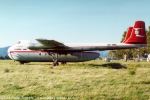 I first had contact with Paul Davidson of the Argosy Trust in December 1996 via the Internet, and we have been in occassional correspondence since. In April of 1998 I had an opportunity to travel to the South Island. Since I was passing through Blenheim to visit on old friend, I arranged with Paul to visit the Argosy on April 5th. After calling at Paul's home to obtain the keys to access the aircraft we walked up the road and through the grounds of RNZAF Woodbourne. ZK-SAE was located on a farm next to the base.
I first had contact with Paul Davidson of the Argosy Trust in December 1996 via the Internet, and we have been in occassional correspondence since. In April of 1998 I had an opportunity to travel to the South Island. Since I was passing through Blenheim to visit on old friend, I arranged with Paul to visit the Argosy on April 5th. After calling at Paul's home to obtain the keys to access the aircraft we walked up the road and through the grounds of RNZAF Woodbourne. ZK-SAE was located on a farm next to the base.
(The base buildings are visble in the background of this image).
|
|
 Since the object of the visit was to get photos, I started with a quick walk-around. It was a bright sunny autumn day, so the conditions weren't ideal (lots of shadow and contrast). This nose port quarter view illustrated the bulbous nose and unusual layout of the Argosy. I feel the aircraft is quite elegant in the air, but it doesn't look its best on the ground!
Since the object of the visit was to get photos, I started with a quick walk-around. It was a bright sunny autumn day, so the conditions weren't ideal (lots of shadow and contrast). This nose port quarter view illustrated the bulbous nose and unusual layout of the Argosy. I feel the aircraft is quite elegant in the air, but it doesn't look its best on the ground!
ZK-SAE is basically externally complete (some parts are stored inside the aircraft), but it lacks engines. This image which illustrates the basic layout also shows the empty nacelles. The designation SAFE Air Cargo was introduced in the mid-1980's with the move away from passenger work. The markings above the name 'Merchant Enterprise' indicate the aircraft carried the Royal Mail.
|
|
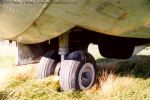

Moving in a little closer, these images illustrate the solid nature of the nose gear on the Argosy. Somewhat necessary for a freighter with a MTOW of over 42 tonnes. The lighting is not the best, but I think you can get the idea.
|
|
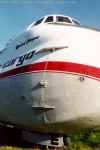
Moving around to the port side, here is a chance to check out the hinges on the forward cargo door - very solid. It also gives a good impression of the height of the flight deck. I'm 173cm (5'7) and was standing to make this photograph. Its not a Jumbo jet, but its still a fair way up! Note the vortex generators on the upper fuselage behind the flight deck. Note also the porthole (unused) behind the cargo door.
Moving to the rear is the rather large main undercarriage leg. I have put the images for both sides of the aircraft together for easy comparison - the structures appear to be identical. Note the location of the exhause from the Rolls Royce Dart engine - and the black markings used to mask the consequences.
|
|

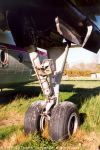
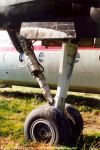
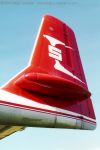
|
|
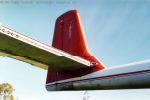
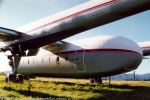
To the rear are the distinctive booms and tail surfaces. The leading edge from the stabiliser is stored in the fuselage. The stylised wings and 'S' of SAFE Air appear on the vertical surfaces.
Access to the aircraft was obtained through the door on the port side - a ladder being stored inside the fuselage.
|
|

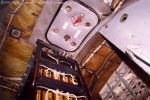
The Argosy Trust was able to obtain one of the 'passenger capsules' along with ZK-SAE. I moved forward through this into the cargo hold (more on the capsule below). The image to the far left shows the view forward. Visible on the right are some of the leading edge fittings stored in the hold. On the left is the ladder providing access to the flight deck. The nose is visible through the door beyond the drums. The image on the left is the view up the ladder into the flight deck. An avionics rack and the escape hatch in the roof are visible.
|
|
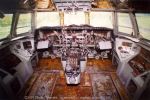
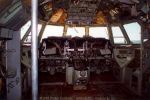 As can be seen from these two images, the flight deck was thoroughly gutted after the aircraft was removed from service. The Argosy Trust is seeking parts to commence restoration work on this section of the aircraft. Without the seating this area is extremely roomy.
As can be seen from these two images, the flight deck was thoroughly gutted after the aircraft was removed from service. The Argosy Trust is seeking parts to commence restoration work on this section of the aircraft. Without the seating this area is extremely roomy.
|
|
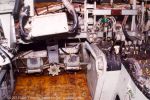
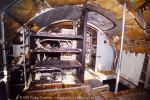
At right is a closer view of the aircraft controls. To the left is a view looking toward the rear of the cockpit. This shows the wiring looms, and the access and escape hatches. Some idea of the size of the flight deck can be gained from noting the pole next to the hatch - which appears in this picture and the one looking forward (above).
|
|

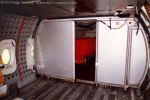
Moving back through the aircraft, these two images show the hold looking to the rear. The image on the far rear is from the forward bulkhead (the position of the drums can be compared with the images above), and the other image is from the base of the ladder. Both images show the 'passenger capsule' loaded in the rear of the aircraft.
|
|
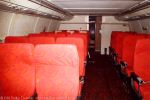
The 'passenger capsule' provided a comfortable environment to transport passengers in a freight aircraft. The seating arrangements are what would typically be expected in an airliner, and the 'capsule' provided some sound insulation. The decor is also noticeably '70's.
The rear cargo door can be seen through the access way at the rear.
|
|
At the rear of the aircraft is a small area between the passenger capsule and the rear cargo door into which the side access door also opens on the starboard side. This is set up with service facilities for the flight attendant. The image on the left below is looking aft from the passenger capsule door. The centre image is looking further aft to the rear cargo door. The image on the right is looking forward from the same point. It shows the rear of the passenger capsule, and the roof space above the capsule running forward. On the bulkhead can be seen the flight attendant's folding seat.
|
|
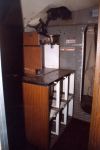

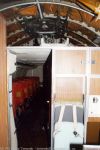
|
|

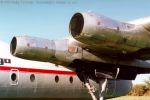
At this point I exited the aircraft - jamming my finger while folding the ladder (which is why there's no hatch photo!). I finished up with the image on the left of the empty engine nacelles on the port wing (anybody got a spare RR Dart?), and a couple more of the fuselage. Then it was a long walk back across RNZAF Base Woodbourne to return the key, before heading off to the Omaka airfield.
|
|
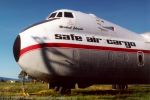
My thanks to Paul Davidson and the Argosy Trust for allowing me to visit and photograph the aircraft.
If anyone out there can help with parts (particularly cockpit fittings and instruments) and information (manuals, etc) on Argosies, please contact Paul Davidson at paul@argosy.co.nz.
|
My second visit to the Argosy was in April 2000. By this time the aircraft had been relocated to its new home. Unfortunately the weather was not as kind as my first visit. As can be seen in the following pictures the aircraft looks stunning in its renewed paint scheme.
|
|
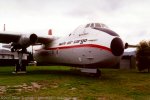

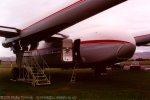
|
|

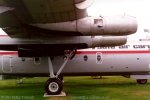
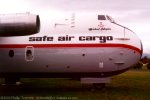
|
|
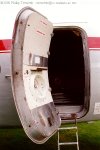
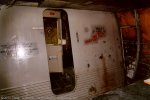
|
Since these pictures were taken the Argosy has had propellers added to the nacelles which has improved the look of the aircraft again.
 © 1998-2002 Phillip Treweek, all rights reserved
© 1998-2002 Phillip Treweek, all rights reserved
I first had contact with Paul Davidson of the Argosy Trust in December 1996 via the Internet, and we have been in occassional correspondence since. In April of 1998 I had an opportunity to travel to the South Island. Since I was passing through Blenheim to visit on old friend, I arranged with Paul to visit the Argosy on April 5th. After calling at Paul's home to obtain the keys to access the aircraft we walked up the road and through the grounds of RNZAF Woodbourne. ZK-SAE was located on a farm next to the base.
Since the object of the visit was to get photos, I started with a quick walk-around. It was a bright sunny autumn day, so the conditions weren't ideal (lots of shadow and contrast). This nose port quarter view illustrated the bulbous nose and unusual layout of the Argosy. I feel the aircraft is quite elegant in the air, but it doesn't look its best on the ground!
As can be seen from these two images, the flight deck was thoroughly gutted after the aircraft was removed from service. The Argosy Trust is seeking parts to commence restoration work on this section of the aircraft. Without the seating this area is extremely roomy.